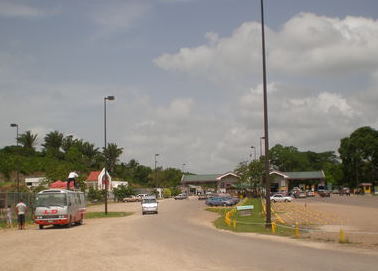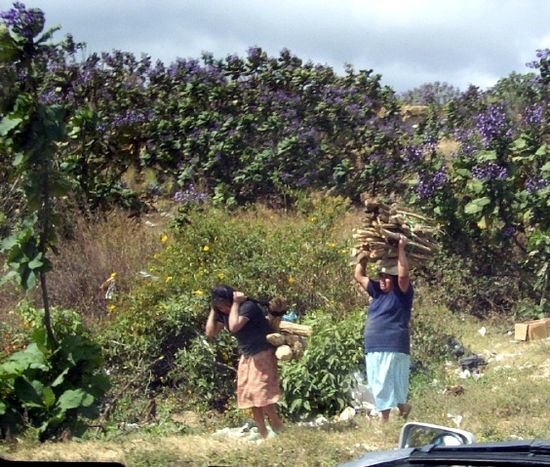South by West- camping from Alaska to Nicaragua
16- Pyramids of Tikal
Pyramids of Tikal; Obsidian saws; Jungle cures; Guatemalan army; Belize stand off; Money changers; Bridge entry fee; Border crossing; in Belize, --------------------------------------------------------------------------------------
When a person encounters Tikal for the first time, he almost feels as though he's visiting an abandoned Hollywood stage for Indiana Jones movie [ as a matter of fact, Stars War I was shot in Tikal ]. It is difficult to believe that you are visiting an ancient Mayas ruins.
It is hard to believe that the Mayas were able to clear the virgin jungle using only obsidian axes and saws. There are trees 3' - 4' in diameter, tough hardwood, that are difficult to cut even with chain saws. Well, they somehow managed to do it.
In limestone quarries, also dug out of of jungle, they cut large blocks using stone chisels. Then they carried these blocks on their backs to Tikal to build pyramids, temples and palaces. They levelled the ground, paved it with stones and excavated huge underground cisterns to collect rain water. They crushed limestone and burned it in bonfires to produce plaster that survives to this day.
Some of the pyramids were over 200 feet high. The walls of the pyramid were covered with plaster and then painted. Paints or rather dyes were made from roots, barks or leaves of different plants, shells and stone There were thousands other tasks necessary to support and feed the builders. The Mayas didn't know metals and they had no beasts of burden. The wheel was sacred and was used only for religious purposes. Everything was done by manual labour. It is all incredible and mind boggling.
At its peak Tikal was the capital of the Empire of ancient Maya. It sprawled over 30 square km and had a population of 100 000. Then around 9th century the Mayan civilization collapsed and archaeologists are still debating why. Some suggestions sound very familiar: deforestation, overpopulation, climate change. Tikal was reclaimed by the jungle and was not discovered until 1848. Walking on the cleared path through the jungle one can see many mounds that hide temples, buildings and much more, that archaeologists have barely mapped.
Our Mayan guide was a walking medical encyclopaedia of the jungle. If what he says was true, there is no need to see a doctor. Most ailments could be cured by walking along the trail in the jungle, by picking a leaf to chew or rub on, or by gathering bark or root to boil for tea. Actually, there are many sick people that come here to see the shaman for a cure. And they are not just local people. Some come from "civilized" countries with modern medicine and science. It is terrible to see the jungle in Guatemala logged out or cleared for cattle ranches.
Mayas were still using the ruins for their ceremonies and meditations. I was really spooked when I stuck my nose into one room and there was an Indian, almost naked, looking just like an ancient Maya priest, sitting cross legged, meditating.
Everything was so old and little care was taken to protect it and preserve it. There was hardly any security around, vandals come and go, leaving some walls covered with graffiti, old and fresh. The first modern vandal was a British archaeologist Maudslay who in 1880's lived for a year in the temple and carved his name on the wall. His graffiti is now protected like old frescos. Writing about Tikal gives little justice. One really must see it, for few days, to absorb and appreciate. We stayed for four days and then continued to Belize.
On the way we saw the Guatemalan army on the move. It keeps a low profile now. In the civil war it gained a bad reputation for going into Indian villages and killing and murdering at random. The convoy we saw looked like it was just returning from a battle or raid. The first truck was full of soldiers bristling with rifles. Second was loaded with mattress, tables, chairs and other necessities of army life. Then a few more trucks loaded with bags and boxes. The last truck was empty, picking up what fell off the convoy.
There was no traffic on the road to Belize except for an occasional truck. After a few miles of pavement it became an atrocious, potholed dirt road. The reasons for this condition go back more than 200 years. After loosing another war with Britain, The Spanish crown was forced to give Britain logging rights to the country between Hondo and Belize rivers. In this area grew huge mahogany trees needed by British Navy. Later British declared this area their colony and named it British Honduras. After independence it became Belize but there was a problem. Guatemala claimed this land was never ceded to Britain and was part of Guatemala. Both countries are barely on speaking terms. But thanks to the British, Belize is the only English speaking country South of USA.
...the "bridge Fee" collected here was not the "Entry fee" and it was not the border crossing to Belize....
The Guatemala side of the border crossing was confusion of people, cars and money changers offering "best deal" to change Quetzals for Belize dollars. Well, we were seasoned travellers by now and knew these "best deals". So we stopped at the gas station and spent remaining quetzals on fuel. It was a mistake. Gas was so expensive, that even the money changers would have given us a better deal.
I left cursing and was stopped by a gate across a bridge. A man in uniform was collecting "entry fee".
I was not going to get ripped off again! We had already paid the entry fee coming to Guatemala and I refused to pay . The man would not lift the gate and we had an impasse. I pulled into a parking lot behind a bus and talked to the driver. He told me that this was not a border crossing but a bridge to the town and the man was a policeman, collecting road maintenance tax. [They needed it] So I went humbly back to the policeman and apologized. We had no Quetzals and he would not take Canadian dollars. Fortunately Sue found US$1 and he let us through to the town. The border was another km down the road.

...the border crossing to Belize was small, fast and efficient
There was no exit fee to pay, we got our passports stamped and were in Belize. There was no waiting, no paper shuffling, no confusion, no crowds, no stalls, no money changers. There was no garbage along the highway! No overloaded trucks! They lived in bungalows! They speak English, it was civilized country! But beware: Belize is expensive! Somebody has to pay for garbage collection, roads, etc, just like in Canada.

Not uncommon sight: women carrying heavy load...
| Start of journey: | January 2003 |
| Duration: | 5 years |
| End of journey: | January 2008 |
Mexico
Guatemala
Belize








